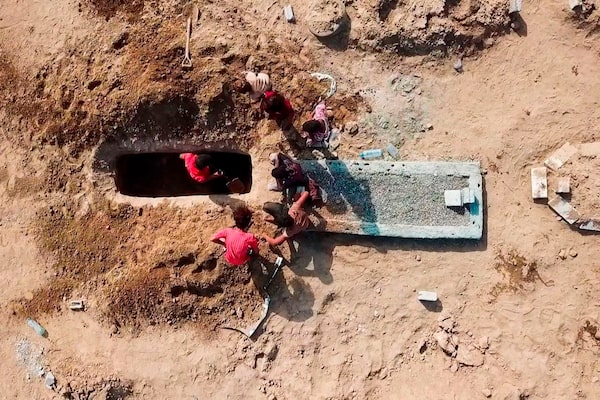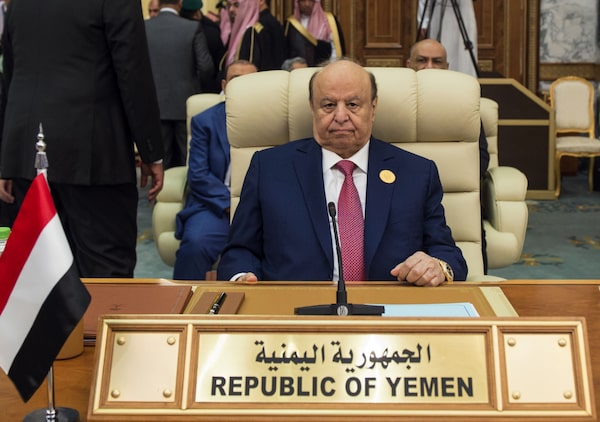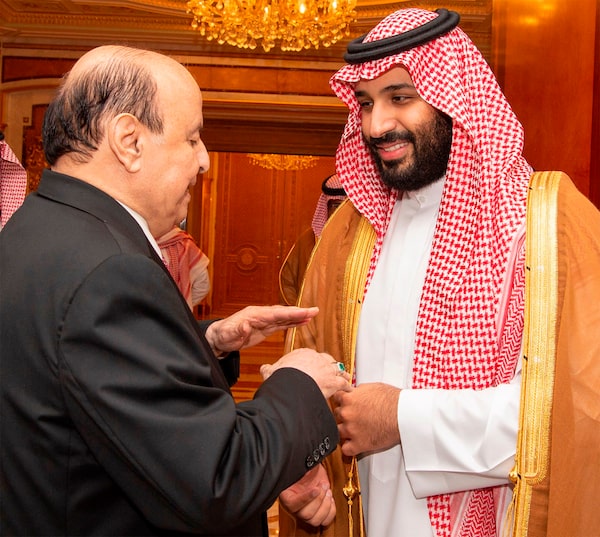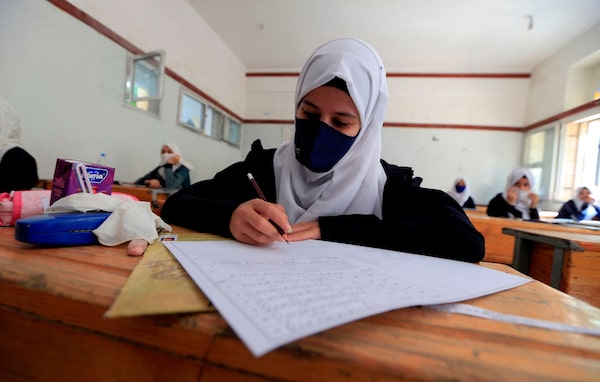
Gravediggers bury a body at Radwan Cemetery in Aden, Yemen, where dozens of fresh graves are a testament to the rising toll of the COVID-19 pandemic.The Associated Press/The Canadian Press
What happens when a country declared by the United Nations to be “the world’s worst humanitarian crisis” is struck by a pandemic?
Embroiled in a six-year old civil war, with cholera and famine present in many parts of the country, the novel coronavirus is just the latest threat for civilians trying to survive. Yemenis are caught between two sides of an international proxy war that has brought air strikes and total bureaucratic breakdown for six years. More than 112,000 people have died as a direct result of the conflict including civilians and militants. Humanitarian needs are urgent, amplified by the late, but aggressive arrival of COVID-19, and yet this year’s international donor funding falls more than $1-billion short of what is needed to meet civilian needs. Every day without a diplomatic solution is one step closer to total collapse as humanitarian funding dries up.
In some of the bleakest assessments yet, a senior United Nations official said the lack of funds had led to the closure of primary health care facilities for 1.8 million people and reduced food aid for 8 million Yemenis at a moment when “famine is again stalking the country.”
Assistant Secretary-General for Humanitarian Affairs Ramesh Rajasingham called on donors to pay their pledges – singling out the country’s Gulf neighbours – and for countries who had not pledged aid, to step up and help if the agency is to avert deeper cuts.
“At the end of the month, we will reduce water and sanitation programs by half in 15 cities. In September, we’ll stop supporting nearly 400 additional health facilities, cutting off 9 million people from medical care. We’ll also stop treating more than a quarter million severely malnourished children,” Mr. Rajasingham told the UN Security Council.
Here’s a primer on the history behind the conflict, the parties involved and the pandemic’s role in the crisis.
Yemen’s current crisis: A snapshot

Areas of control as of Aug. 20
Houthi
Hadi
Ansar al-Sharia, AQAP*
*Al-Qaeda in the Arabian Peninsula
0
200
KM
SAUDI ARABIA
OMAN
YEMEN
Sanaa
Socotra
Gulf of Aden
SOMALIA
THE GLOBE AND MAIL, SOURCE: TILEZEN;
OPENSTREETMAP CONTRIBUTORS; LIVEUAMAP

0
200
KM
SAUDI ARABIA
OMAN
YEMEN
Sanaa
Socotra
Gulf of Aden
Areas of control as of Aug. 20
Houthi
Hadi
Ansar al-Sharia, AQAP*
*Al-Qaeda in the Arabian Peninsula
THE GLOBE AND MAIL, SOURCE: TILEZEN;
OPENSTREETMAP CONTRIBUTORS; LIVEUAMAP

0
100
KM
SAUDI ARABIA
OMAN
YEMEN
Sanaa
Socotra
Gulf of Aden
IRAQ
IRAN
SAUDI
ARABIA
SOMALIA
EGYPT
Areas of control as of Aug. 20
Houthi
YEMEN
SUDAN
Hadi
Ansar al-Sharia, AQAP*
0
1,000
ETHIOPIA
*Al-Qaeda in the Arabian Peninsula
KM
THE GLOBE AND MAIL, SOURCE: TILEZEN; OPENSTREETMAP CONTRIBUTORS; LIVEUAMAP
CIVIL WAR
Today, Yemen’s civil war involves three competing factions: a Saudi-led coalition composed of Gulf States that supports Sunni President Abd Rabbu Mansour Hadi, and the Houthis, an Iranian-backed movement of Shia Muslims; and the Southern Transitional Council, a secessionist group supported by the United Arab Emirates. In late June, the STC and Saudi-led coalition agreed to form a united government and end armed hostilities, focusing on the Houthis as a common enemy.
Drone and missile attacks escalated between the allies and Houthis in June and July, with Saudi air strikes hitting the Northern cities of Saada and Sana’a. The United Nations is trying to broker an agreement between the two sides, but envoy Martin Griffiths has expressed concern to the UN Security Council that “there is a real risk these negotiations will slip away, and that Yemen will enter a new phase of prolonged escalation.”
PANDEMIC
It’s not clear how many COVID-19 cases Yemen has, as testing supplies are severely limited, and infected people are known to avoid seeking health care for fear of stigma or catching the disease in hospital. But UN Secretary-General Antonio Guterres said in a recent speech that the UN believes Aden, the largest city in southern Yemen and the Hadi government’s de facto capital, has one of the highest coronavirus mortality rates in the world. “We are in a race against time,” he urged.
The pandemic is a serious threat, but it only magnifies larger problems, Roger Gutierrez, Head of Emergencies in Yemen at Medecins Sans Frontieres (Doctors Without Borders), told The Globe from Sana’a. The local supply of protective and testing equipment was already limited when the pandemic struck, and the closing of airports for several months made things worse. “Coronavirus just puts even more stress on a health system that has essentially collapsed after six years of war,” he says. According to the International Rescue Committee, Yemen, a country of 28.5 million, could see more than 85,000 deaths.
CHOLERA
Before COVID-19 came, Yemenis were struggling with another deadly illness made worse by the lack of clean water. A 2016-17 outbreak of cholera was the largest wave in modern history, Mr. Gutierrez notes. While Yemen fought it back, the disease remains in 22 of the 23 governorates in the country as of this past July, and COVID-19 restrictions have complicated efforts to treat it. According to the World Health Organization, 1,574 Yemenis died from suspected cases of cholera between January 2018 and July 2020.
AID SHORTAGE
In June, an annual donor conference hosted by the United Nations and Saudi Arabia, which sets the pool of funding available for Yemen for the next year, reached only US$1-billion, far below the $2.1-billion requested by aid agencies. Canada pledged US$29-million, down from $35.4-million the year before. Oxfam estimates that the funding gap will put five million Yemenis at risk of losing access to food and clean water. UNICEF has warned that the amount of malnourished children could reach 2.4 million by the end of the year.
FAMINE
Famine is not new to the conflict, but a recent reduction of humanitarian aid has raised concerns about more malnutrition to come. In July, World Food Programme spokesperson Elisabeth Byrs told journalists that 10-million Yemenis were facing an acute food shortage, and 360,000 children were at risk of dying from starvation without treatment.
Yemen’s turbulent history

President Ali Abdullah Saleh votes in parliamentary elections in 1997, nine years after he became the ruler of a Yemen united between the formerly independent north and south.The Associated Press
NORTH VS. SOUTH
During the Cold War, Yemen was split between two states. After the British withdrew from Southern Yemen in 1969, a socialist state was formed there, supported by the Soviet Union, while the North was ruled by a Shia imam. For years, the two states fought, while also dealing with internal civil conflicts. They finally came to a diplomatic solution for reunification in 1972, which took over 14 years to implement, pushed forward in part by the disintegration of the Soviet Union. President Ali Abdullah Saleh was chosen to preside over the unified Yemen in 1990, governing a country deeply divided among sectarian, tribal and ideological lines.
THE ARAB SPRING
Mr. Saleh led the country for over three decades until the Arab Spring uprisings of 2011. At the time, Yemen was the poorest country in the Middle East. To say the Arab Spring triggered Yemen’s current conflict would be misleading – the turbulence of the uprising only exacerbated existing sectarian and political tensions in Yemen. Even after Saleh stepped down and transferred power to his Vice-President, Abd Rabbu Mansour Hadi, in 2012, the extent of discontent with the regime was at that point unstoppable.

Yemen's President Abd Rabbu Mansour Hadi, shown in 2019.BANDAR AL-JALOUD/AFP/Getty Images/AFP/Getty Images
THE CIVIL WAR BEGINS
In 2014, the civil war officially began when the Shia Houthis took control of Yemen’s capital, Sanaa. Mr. Hadi, a Sunni leader, fled to the South, where he rallied Saudi Arabia, and its Gulf allies, to support him in defeating the Houthis. As the conflict continued, the Southern Transitional Council, supported by the United Arab Emirates, made its own play for secession in parts of the south, including Aden. The STC declared self-governance in those areas this past April. Each side was found by the UN to commit grave abuses, including the use of child soldiers, torture and rape. The civilian death toll has been immense: this past March, the UN verified the deaths of 7,700 civilians thus far in the conflict, primarily attributed to Saudi-led air strikes. Other human rights monitors suspect the death toll of civilians to be far greater – the Yemen Data Project estimates that over 30 per cent of the Saudi-led coalition’s bombing raids have hit civilian infrastructure, like water stations, schools and roads.
An armed man from the Muhamasheen (marginalized) community in Sanaa shouts slogans during a pro-Houthi gathering on July 15.Khaled Abdullah/Reuters/Reuters
How the rest of the world is involved
Like Syria, the Yemeni civil war has attracted support from a number of different countries looking to stake a claim in the future of Yemen. The country is strategically located on major oil and gas shipping routes, along the Gulf of Aden and the Red Sea. Involvement in Yemen’s conflict can also be seen as an attempt to limit Iran’s influence in the region.
But intervention comes at a heavy cost. The United Nations’ Human Rights Council released a report in September indicating that the United States, United Kingdom and France may be complicit in war crimes through their support for the Saudi-led coalition.
IRAN AND HEZBOLLAH
Before the civil war began, the Houthis trained with and fought alongside fellow Shia rebels from Hezbollah, based in Lebanon. Both are allies of Iran, the major Shia regional power. Supporting the Houthis is a way for Iran to damage the oil infrastructure and revenues of regional rival Saudi Arabia. For instance, though the Houthis claimed responsibility for a drone attack on Saudi soil last September that demolished a Saudi Aramco facility, Saudi Arabia and the United States have maintained it was ordered by the Iranian government.
“The Houthis don’t feel much compulsion to quit while they are winning on the ground. The war rallies many Yemenis against the hated foreign Saudis,” says Bruce Riedel, senior fellow at the Centre for Middle East Policy at the Brookings Institute.
AL-QAEDA IN THE ARABIAN PENINSULA
Yemen’s offshoot of al-Qaeda was once considered one of the most dangerous terrorist groups in the world, claiming responsibility for the 2015 Charlie Hebdo attacks and the foiled Christmas Day airline bombing plot. In 2011, AQAP capitalized on the Arab Spring to seize large amounts of territory in the South. Its presence in Yemen and Saudi Arabia has declined in recent years, and the Saudi coalition killed its leader, Qasim al-Raymi, in a drone strike in early 2020.
Operations to eliminate AQAP also add a degree of legitimacy to the Saudi-led coalition air strikes, particularly for Western nations facing domestic pressure to end their involvement for humanitarian reasons.

Mr. Hadi is greeted by Saudi Crown Prince Mohammed bin Salman, in Jeddah, in 2018.BANDAR AL-JALOUD/AFP/Getty Images/Getty Images
SAUDI ARABIA
Saudi Arabia has led the anti-Houthi coalition since 2015, largely to prevent the establishment of an Iranian ally along its southern border. But there are signs that the Saudis are experiencing conflict fatigue. In April, the coalition called for a unilateral ceasefire, citing the coronavirus, though it never came to pass. Analysts say the pandemic was more likely to be an excuse for the Saudis to hit pause and regroup than a genuine call for an end to the violence. It has been reported that the Saudis are co-ordinating with Oman to facilitate back-channel talks to come to a resolution with the Houthis that would allow them to scale back or withdraw.
Analysts suspect that despite being seen as the architect of the Saudi involvement in Yemen, Crown Prince Mohammed bin Salman may want out for reasons beyond the financial expense, knowing the humanitarian disaster further tars his reputation in Western nations.
UAE
Like Saudi Arabia, the Emiratis are concerned with the presence of Iran in the Gulf, and Islamic radicalism via AQAP. They are also motivated to protect Emirati naval bases in Yemen that were strategically located within the Indian Ocean. But the UAE withdrew its forces from Yemen this past February, in the face of declining oil revenues. The UAE is still indirectly engaged through its support for the STC and Saudi-led coalition.
Presidents Donald Trump and Barack Obama have each faced criticism for their governments' Yemen policies.Pablo Martinez Monsivais/The Associated Press/The Associated Press
UNITED STATES
The United States has played a role in the Yemeni conflict since the Obama era, providing weapons and logistical support to the coalition. But U.S. human-rights groups have raised concerns about civilian deaths and the destruction of hospitals by coalition air strikes. Democrat lawmakers have also argued that American power would be better spent by pressing the Iranians to come to the negotiating table.
In April, 2019, President Donald Trump vetoed a resolution that was passed through the House of Representatives calling for an end to U.S. involvement in Yemen. At the time, Secretary of State Mike Pompeo stated, “If you truly care about Yemeni lives, you’d support the Saudi-led effort to prevent Yemen from turning into a puppet state of the corrupt, brutish Islamic Republic of Iran.”
CANADA
In 2014, the Canadian government brokered a C$14 billion deal between Ontario-based General Dynamic Land Systems and the Saudi government to manufacture light armoured vehicles. The Trudeau government approved the deal after the 2015 election.
The Globe and Mail reported in 2016 that Canadian-made LAVs appeared in photographs of confrontations between the Houthis and Saudi backed militia.
After a review of weapons sales to Saudi Arabia, and a freeze on new export permits in November 2018, Global Affairs Canada claimed to find “no credible evidence linking Canadian exports of military equipment or other controlled items to any human rights or humanitarian law violations committed by the Saudi government.” The review investigated both domestic Saudi human rights abuses and violations conducted in Yemen.
Following the murder of dissident Saudi journalist Jamal Khashoggi, Canada announced it would be pausing new export permits in December, 2018, although previously approved permits were processed and shipped. The government then lifted this suspension in April, 2020, citing the same 2018 report on Saudi human-rights abuses. At the time, Foreign Affairs Minister Francois-Phillippe Champagne said General Dynamics would require extensions of export permits to complete the $14-billion deal with Saudi Arabia, a transaction he said is now about 50-per-cent complete.

Masked Yemeni students sit for their final secondary school exams in Sanaa, on Aug. 15.MOHAMMED HUWAIS/AFP via Getty Images/AFP/Getty Images
What’s next, and how you can help
The ceasefire between the STC and the coalition is a hopeful development, but Yemenis are still caught between Houthi and coalition warfare. With the decline in aid from international donors, the humanitarian situation in Yemen is escalating to a dire, unprecedented level of need. According to Mr. Gutierrez of MSF, “we are facing right now a very challenging moment because most of the donors are reducing their aid to Yemen, but the situation is the same, and even getting worse. Our message to the world is: do not forget about Yemen.”
Here are some resources for Canadians looking for ways to contribute:
- The World Food Programme has seen substantial funding cuts for their operations in Yemen, even as Yemenis starve. It is accepting donations here.
- Médecins Sans Frontières continues to operate clinics and hospitals in Yemen, providing life-saving care for coronavirus and cholera, despite attacks on their health facilities.
- Mona is a smaller Yemeni aid organization that delivers food, hygiene kits, clothing and other basic needs to Yemenis, prioritizing locally sourced goods.
- The International Rescue Committee has set up a fund specifically to counteract COVID-19 in Yemen by training mobile health workers and improving sanitation in health facilities.
- Islamic Relief Canada is supporting relief operations in 17 of the 22 Yemeni governments, and is supplying clean water to over 10,000 civilians.
Our Morning Update and Evening Update newsletters are written by Globe editors, giving you a concise summary of the day’s most important headlines. Sign up today.